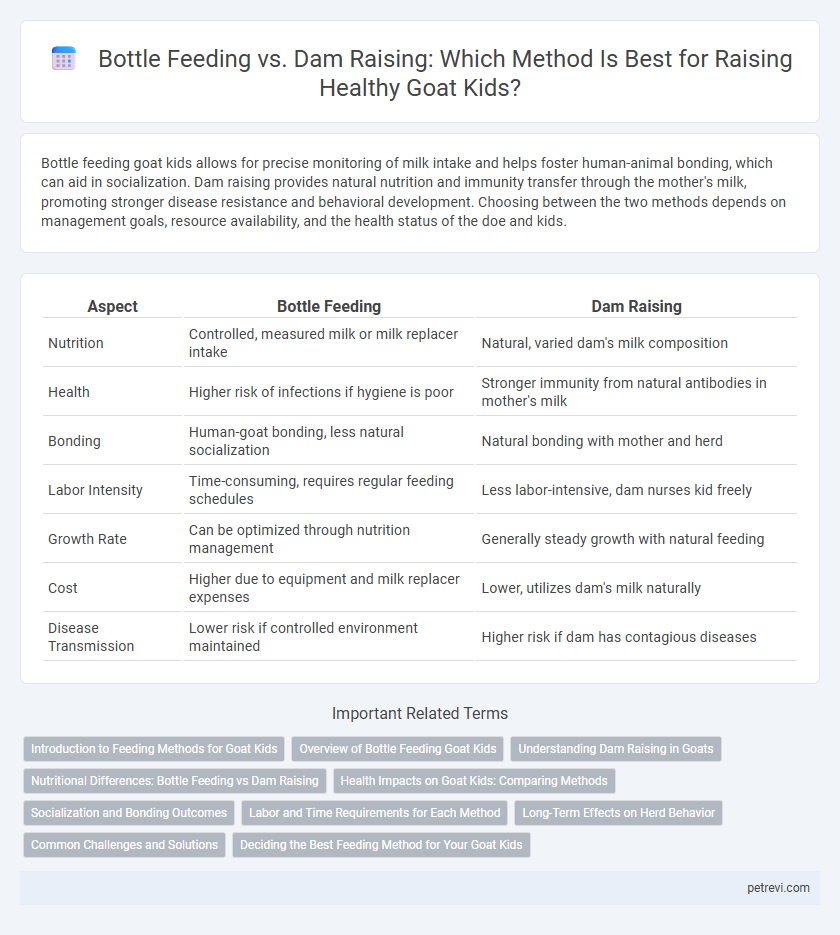Bottle feeding goat kids allows for precise monitoring of milk intake and helps foster human-animal bonding, which can aid in socialization. Dam raising provides natural nutrition and immunity transfer through the mother's milk, promoting stronger disease resistance and behavioral development. Choosing between the two methods depends on management goals, resource availability, and the health status of the doe and kids.
Table of Comparison
| Aspect | Bottle Feeding | Dam Raising |
|---|---|---|
| Nutrition | Controlled, measured milk or milk replacer intake | Natural, varied dam's milk composition |
| Health | Higher risk of infections if hygiene is poor | Stronger immunity from natural antibodies in mother's milk |
| Bonding | Human-goat bonding, less natural socialization | Natural bonding with mother and herd |
| Labor Intensity | Time-consuming, requires regular feeding schedules | Less labor-intensive, dam nurses kid freely |
| Growth Rate | Can be optimized through nutrition management | Generally steady growth with natural feeding |
| Cost | Higher due to equipment and milk replacer expenses | Lower, utilizes dam's milk naturally |
| Disease Transmission | Lower risk if controlled environment maintained | Higher risk if dam has contagious diseases |
Introduction to Feeding Methods for Goat Kids
Bottle feeding goat kids involves manually providing milk using a bottle, ensuring precise control over nutrition and hygiene, suitable for orphaned or rejected kids. Dam raising allows kids to nurse directly from their mother, promoting natural bonding and immune system development through maternal antibodies. Understanding these feeding methods is crucial for optimizing goat kid health and growth in different farming scenarios.
Overview of Bottle Feeding Goat Kids
Bottle feeding goat kids involves manually feeding milk replacer or fresh milk using a bottle, allowing for controlled nutrition and close monitoring of each kid's intake. This method supports early socialization with humans and can help prevent disease transmission from the dam but requires regular feeding schedules and proper hygiene to avoid infections. Bottle-fed kids often develop stronger human bonds and can be easier to manage in small-scale or commercial dairy operations.
Understanding Dam Raising in Goats
Dam raising in goats allows kids to receive natural colostrum and milk, which provide essential antibodies and nutrients for early immunity and growth. This method promotes strong maternal bonding and social learning, improving overall kid health and behavior. By relying on the doe, dam raising reduces labor and feeding costs while supporting natural development processes.
Nutritional Differences: Bottle Feeding vs Dam Raising
Bottle feeding goat kids allows for precise control over milk quality and quantity, ensuring tailored nutritional intake with options like milk replacers fortified with essential vitamins and minerals. Dam raising provides natural, balanced nutrition through the doe's milk, rich in antibodies and bioactive compounds that enhance immune development and gut health. Nutritional differences influence growth rates and disease resistance, with bottle feeding requiring careful management to mimic the dam's nutrient profile for optimal kid development.
Health Impacts on Goat Kids: Comparing Methods
Bottle feeding goat kids can increase the risk of digestive upset and inadequate immune protection compared to dam raising, which provides natural colostrum crucial for passive immunity. Dam-raised kids generally exhibit stronger health outcomes and lower incidences of scours due to consistent maternal care and microbial exposure. In contrast, bottle feeding requires meticulous hygiene and proper milk replacer formulation to prevent bacterial infections and nutritional deficiencies.
Socialization and Bonding Outcomes
Bottle feeding goat kids fosters strong human-animal bonds through frequent direct interaction, promoting socialization with caregivers but may limit natural behaviors and peer bonding. Dam raising encourages natural maternal bonding and social development within the herd, enabling kids to learn species-specific behaviors and social cues essential for healthy group dynamics. Balancing both methods can optimize social skills and emotional well-being in goat kids by combining human interaction with natural herd integration.
Labor and Time Requirements for Each Method
Bottle feeding goat kids demands significant labor and time, requiring frequent feedings every few hours, especially during the first weeks of life, along with constant sanitization of bottles and feeding equipment to prevent infections. Dam raising reduces labor intensity since the mother goat naturally nurses the kids, allowing for less frequent direct human intervention, though it still demands monitoring to ensure kids receive adequate nutrition and maternal care. Efficient management of time and resources depends on herd size and available labor, with bottle feeding favored in situations requiring controlled nutrition or orphaned kids.
Long-Term Effects on Herd Behavior
Bottle feeding goat kids often leads to stronger human-animal bonds but may result in less natural social integration within the herd, potentially causing behavioral issues such as increased aggression or isolation. In contrast, dam raising promotes healthy kid-to-kid and maternal interactions, fostering stable herd hierarchy and social cohesion essential for long-term herd dynamics. Studies highlight that dam-raised kids exhibit more adaptive behaviors and reduced stress levels, contributing to overall herd well-being and productivity.
Common Challenges and Solutions
Goat kids raised by their dam often face fewer health issues due to natural immunity transfer, but dam raising can be hindered by insufficient milk production or maternal neglect, requiring supplemental feeding strategies. Bottle feeding offers precise control over nutrition and hygiene, yet common challenges include ensuring proper milk temperature, preventing aspiration pneumonia, and maintaining cleanliness to avoid infections. Solutions involve using warming devices for milk, practicing careful feeding techniques, frequent sterilization of feeding equipment, and monitoring kid health closely for early signs of distress.
Deciding the Best Feeding Method for Your Goat Kids
Choosing the best feeding method for goat kids depends on factors like health, bonding, and management goals. Bottle feeding ensures precise nutrition and monitoring but requires time and effort, while dam raising promotes natural immunity and maternal bonding but offers less control over intake. Evaluate resources and kid health to optimize growth and wellbeing based on your specific farm environment.
Bottle Feeding vs Dam Raising for Goat Kids Infographic

 petrevi.com
petrevi.com